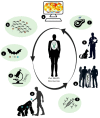Veterinarians and One Health in the Fight Against Zoonoses Such as COVID-19
- PMID: 33195577
- PMCID: PMC7661752
- DOI: 10.3389/fvets.2020.576262
Veterinarians and One Health in the Fight Against Zoonoses Such as COVID-19
Keywords: animal health; emerging zoonoses; forefront; infectious diseases control; public health.
Figures

References
-
- World Health Organization Coronavirus disease 2019 (COVID-19) Situation Report – 195. (2020). Available online at: https://www.who.int/docs/default-source/coronaviruse/situation-reports/2... (accessed August 11, 2020).
LinkOut - more resources
Full Text Sources

